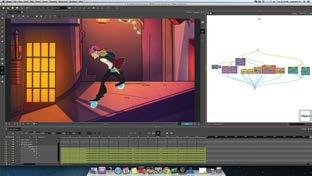
3 minute read
A Quieter Toon Heroine
Though a bit talky and slow, When Marnie Was There — possibly the last movie to come from Studio Ghibli — is a breath of fresh air. Review by Charles Solomon.
Although it may become the last feature made by Studio Ghibli (a lugubrious distinction if ever there were one), When Marnie Was There is a warm, gentle film that continues the pattern of Japanese animators creating heroines who are more complex, interesting and individual than their Western counterparts.
Released last year in Japan, the English-language version debuted May 22 in New York and Los Angeles, and is expanding to other cities through early July.
“I hate myself,” declares alienated adolescent Anna Sasaki (Hailee Steinfeld). When she suffers a debilitating asthma attack, her foster mother Yoriko (Geena Davis) sends Anna from her home in Sapporo to a small beach town. She can stay with her cheerfully eccentric Aunt Setsu (Grey DeLisle) and Uncle Kiyomasa (John C. Riley) while she rebuilds her strength.
Although she’s usually polite, Anna keeps her distance from her relatives and the local people. Her aunt tries to set up a friendship with Nobuko (Raini Rodriguez), the bossy daughter of a prim friend, but her efforts fall flat. The only thing that interests Anna is the Marsh House, a seemingly abandoned mansion half-hidden by trees. Marnie (an appropriately soft-spoken Keirnan Shipka), a lovely blonde girl, emerges from the house and quickly forms a powerful bond with Anna.
The two share mini-adventures, swap confidences, laugh and lament their problems. Anna resents her parents and grandmother for dying and leaving her alone, and she suspects that Yoriko only took her in for the government payments she receives. Despite her wealth and beauty, Marnie also feels abandoned: her glamorous parents gad about, leaving her in the care of a stern governess and indifferent maids.
What Is Real?
But when a Tokyo family buys the Marsh House, Anna becomes confused. How can they move into Marnie’s home? She recognizes the rooms she’s visited with Marnie, but everything is different. Sayako (cheerfully perky Ava Acres), the daughter of the new owners, confides to Anna that she’s found a diary in her room that had been hidden there decades earlier — by Marnie.
As he did in The Secret World of Arietty, director Hiromasa Yonebayashi suggests supernatural phenomena may lurk beneath seemingly normal life. In Arietty, the tiny Borrowers shared a house with the elderly Sadoko and her nephew Sho. In his new film, Marnie feels present but elusive, like the shifting clouds at the seashore.
Yonebayashi and his writers skillfully focus and enrich Joan G. Robinson’s rambling juvenile novel. In the original book, Anna was so determinedly alienated and antisocial; she was shipped off before the end of the school term to stay with the Peggs, an effortfully colorful lower class couple whom her guardian apparently knew. Making Anna asthmatic creates a more plausible reason for her to move to the shore; making her an artist gives her a reason to be fascinated by the Marsh House and the way light plays over its walls. This Anna is more likable and understandable than the balky heroine in the book, and her aunt and uncle emerge as more dimensional characters than the Peggs, who felt like a plot device.
Quiet, sometimes slow, Marnie is a well-crafted tale. Adolescent Complexity

The filmmakers capture the emotional intensity — and over-intensity — of adolescence. When Anna and Marnie share secrets and pledge eternal friendship their tears are genuine. Anna’s depth and complexity offer a refreshing change from the relentlessly spunky heroines in recent American features. Although they died when she was quite small, Anna misses her parents and grandmother, but her sorrow is mixed with a very believable anger at being abandoned. Although she feels genuine affection for Yoriko, she fears being betrayed yet again. At times, the pacing in When Marnie Was There drags, and the presence of the title character requires some long explanatory scenes with the painter Hisako (Vanessa Williams) — as it did in the book. Yonebayashi adds visual interest to this sequence by having Anna silently witness the other characters’ memories, recalling how journalists Genya and Kyoji found themselves in the tangled memories of aging film star Chiyoko in Satoshi Kon’s Millennium Actress. Although the backgrounds are handsome, they lack the individuality of other Ghibli features. The English dub feels talkier than the Japanese original.
Those caveats aside, When Marnie Was There is an interesting, well-crafted film that offers viewers a welcome alternative to the familiar heroines and sitcom gags in many American films. Animation fans can only hope the film succeeds and keeps production alive at the storied Studio Ghibli. [










